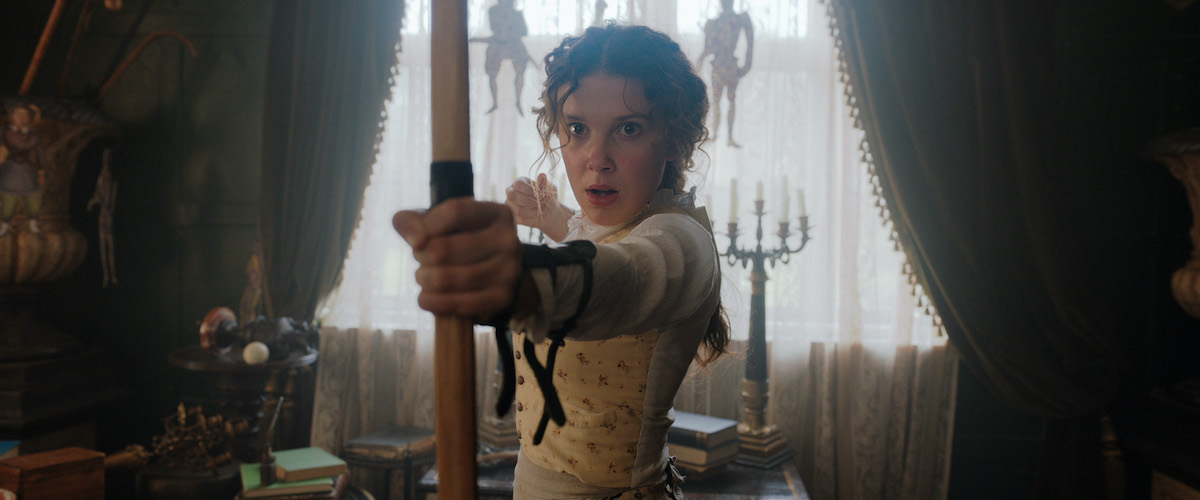Millie Bobby Brown plays the titular character in Harry Bradbeers’ Netflix film “Enola Holmes.” Photo from insider.com.
I really wanted to love “Enola Holmes” after seeing the trailer and positive reviews, but after two long hours, I was just left with an underwhelming feeling of “it’s just an okay film.”
“Enola Holmes” tells the story of Mycroft and Sherlock Holmes’ little sister, Enola, played by “Stranger Things” star Millie Bobby Brown, who wakes up to find that her mom, Eudoria, played by Helena Bonham Carter, has gone missing. We are then taken on a two-hour mystery adventure, narrated by Enola, as she tries to find where her mom went and why.
As I watched Brown break the fourth wall time and time again, I began to wonder if I was just watching a children’s version of “Fleabag.” So it wasn’t exactly surprising when I realized that the director of the film is Harry Bradbeer, best known for his work on both “Fleabag” and “Killing Eve.” Of course, this meant Fiona Shaw, a featured actress in both serieses, had to make an appearance in the film. Shaw played the headmistress of a finishing school Enola adamantly did not want to attend, but her older brother Mycroft, now her handler, was forcing her to.
This was my main problem with the film: the plot. The trailer and the start of the movie leads audiences to believe that it’s all about Enola trying to find her mother, and all of a sudden multiple side plots and subplots that quite honestly just feel like distractions begin appearing.
I can sum up the entire movie in just this sentence: Enola Holmes is not just a detective and hero, but a girl detective and hero.
“Enola Holmes” takes place in England in the year of 1844, so clearly not the best time to be a girl seeking independence for herself. Her mother had raised her to be a bright, self-sufficient girl who does not need a man, nor her older brothers, telling her what to do and how to do it. So when her eldest brother Mycroft becomes her handler and tries to turn her into a proper young lady so she can one day marry a fine upstanding man, we enter our first side plot.
Enola decides to dress up as a boy and run away, both from her fate at finishing school, and to try and find her mother. On the train she meets another young runaway, Viscount Tewkesbury, played by newcomer Louis Partridge who appears to be auditioning for the role of the younger, British Timothée Chalamet from the minute he appears on screen.
Enola manages to save his life from a villain in a bowler hat and she is quite literally sidetracked from her mission, taking the audience along with her. This is about the time where I started frequently checking how much time was left in the movie. All of a sudden we had multiple villains: Mycroft, the headmistress, bowler hat man and even potentially her own mother, but there were no answers to any of the mysteries that were arising. With the amount of characters and side plots, it’s easy to get lost, and many characters do, going long stretches of the film without appearing or even being mentioned.
Through cheesy lines and some admittedly badass action sequences, Enola is consistently praised or looked down upon for not just being a young detective and fighter, but a girl as well. It makes sense given the fact that it is the late 19th century and she is just 16, but there were few scenes in the entire film that didn’t feel like they were just there to prove that girls could be smart and strong, and it all made it feel juvenile. Maybe if I was a 12-year-old girl, I would have enjoyed this film much more.
Besides checking the time left on the film–if it had been shown in theaters like originally planned instead of streamed on Netflix, I doubt I could have made it through the entire two hours–I spent a good amount of time wondering why it was rated PG-13. There was nothing remotely adult about it. At exactly an hour and 40 minutes, at the film’s climax, I finally had a moment where I began to understand just why it may have gotten the rating, but I don’t think I wouldn’t recommend this as particularly exciting to anyone older than Enola herself.
Otherwise, audiences could make a fun game out of spotting “Harry Potter” cast members and realizing that Mycroft is played by Sam Claflin, completely unrecognizable from his role as Finnick Odair in “The Hunger Games” series, or trying to see Henry Cavill as Sherlock and not Superman.
While the plot and dialogue were in desperate need of revision, the actual directing and style of the film was interesting and enjoyable, with title cards and animated cutscenes used for flashbacks, clues and revelations as Enola narrated. There were beautiful shots of the English countryside sprinkled throughout and the multiple action sequences were thrilling.
The only true saving grace of the plot was that it managed to be unpredictable, but whether that was a stroke of genius from Jack Thorne or from the fact that the actual plot gets to be so muddled and confused along the way with added villains and mysteries and lack of actual answers until the final 20 minutes is anyone’s guess.
Overall, it was an underwhelming mystery and adventure with good performances from Brown and her supporting cast, but it was certainly not made for college-age students. The entire film ended up making a cliched joke of itself by focusing on the fact that she was a girl rather than the fact that she was a brilliant detective, fighter and charming lead. I look forward to the day where a male writer manages to write a hero that happens to be a girl, rather than a girl hero.
Rating: 7/10

